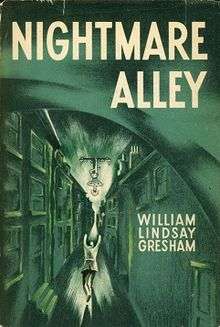Nightmare Alley
 First edition | |
| Author | William Lindsay Gresham |
|---|---|
| Country | United States |
| Language | English |
| Publisher | Rinehart & Company |
Publication date | 1946 |
| Media type | Print (hardback & paperback) |
Nightmare Alley is a novel by William Lindsay Gresham published in 1946. It is a study of the lowest depths of showbiz and its sleazy inhabitants – the dark, shadowy world of a second rate carnival filled with hustlers, scheming grifters, and Machiavellian femmes fatales.
Gresham attributed the origin of Nightmare Alley to conversations he had with a former carnival worker while they were both serving as volunteers with the Loyalist forces in the Spanish Civil War. Gresham wrote the novel, his first, while working as an editor for a "true crime," pulp magazine in New York City during the 1940s. He outlined the plot and wrote the first six chapters over a period of two years, then finished the book in four months. Each chapter is represented by a different Tarot card.
Plot
Stanton Carlisle watches the geek show at a Ten-in-One where he has recently begun working. He later asks the carnival's talker Clem Hoately where geeks come from. Clem explains that geeks are "made": a sideshow owner finds an alcoholic bum and offers him a temporary job. Initially, the bum uses a razor blade to slice chickens' necks and fakes drinking the blood. After a few weeks the owner threatens to fire the bum in favor of a "real" geek, and the fear of sobering up terrifies the bum into actually biting the chickens. Thus, a geek is made.
Stan performs sleight of hand tricks in the sideshow but studies under the carnival's mentalist Zeena to learn a refined "code" act, where performers memorize verbal cues that allow them to appear psychic by accurately answering written audience questions. Stan also begins to pick up Zeena's talent for cold reading. He eventually leaves the carnival with beautiful and naïve electric girl[1] Molly Cahill to perform a team code act.
Their act becomes very successful, but Stan grows bored and transforms himself into Reverend Carlisle, an upstanding Spiritualist preacher offering séance sessions with the help of his medium (Molly, appearing as "Miss Cahill" to obfuscate their relationship). Stan gains a devoted following, but the stress of leading a false life leads him to seek the help of psychologist named Lilith Ritter, who seduces and then begins controlling him. Stan pleads constantly for them to go away together, and Lilith eventually agrees, suggesting the Rev. Carlisle swindle a rich man for the getaway money. They settle on Ezra Grindle, a ruthless auto tycoon with a skeptical interest in the occult. Stan manages to convince Grindle of his powers, and the businessman becomes a devoted spiritualist.
Stan keeps Grindle hooked by promising to reunite him with his deceased college sweetheart Dorrie, who died in a botched back-alley abortion Grindle convinced her to seek. A reluctant Molly plays "Dorrie" in a series of sessions but eventually breaks character, destroying the illusion, and Grindle vows revenge for Stan's lies. Stan tells Molly to go back to carnival life. At Lillith's suggestion he decides to go into hiding with Grindle's money but discovers that Lillith has stolen it. When he confronts her, she threatens to have him committed to a mental institution, and he narrowly escapes. He flees and resorts to performing as a mentalist at increasingly shoddy venues, barely evading the men Grindle continually sends after him. Eventually he becomes a hobo, staying afloat by giving Tarot readings and selling horoscopes. He descends into alcoholism and depression.
His life in shambles, Stan finds a carnival owner and asks to join the sideshow as a palm reader. The owner gives Stan some whiskey but refuses his proposal, saying the show is full. But as Stan begins to drunkenly stumble out, the owner changes his tune and invites Stan back in with a job offer: "Of course, it's only temporary – just until we get a real geek."
Reception
In a 2010 review of the book, the Pulitzer Prize–winning book critic Michael Dirda proclaimed, "I was utterly unprepared for its raw, Dostoevskian power... It's not often that a novel leaves a weathered and jaded reviewer like myself utterly flattened, but this one did....it's more than just a steamy noir classic. As a portrait of the human condition, Nightmare Alley is a creepy, all-too-harrowing masterpiece."[2]
Author and creative writing professor Dwight V. Swain described the conclusion of Nightmare Alley as an exemplar of a novel with an unhappy ending that was nonetheless a "fitting ending," where the protagonist brought misfortune on himself.[3]
Editions
- (reprinted in) Crime Novels: American Noir of the 1930s and 40s, Robert Polito, ed. (Library of America, 1997) ISBN 978-1-883011-46-8
- 2010 reprint by New York Review Books ISBN 978-1-59017-348-0
Adaptations
Nightmare Alley was also produced as a film noir motion picture starring Tyrone Power in 1947.
A graphic novel adaptation of the novel was produced in 2012 by underground cartoonist Spain Rodriguez.[4]
The novel has been adapted into a musical by Jonathan Brielle, and directed by Gil Cates. The musical opened on 21 April 2010 at the Geffen Playhouse in Los Angeles.[5]
References
- ↑
- ↑ 'Nightmare Alley,' by William Lindsay Gresham, reviewed by Michael Dirda
- ↑ Swain, Dwight V(1990). Creating Characters: How to Build Story People. Cinncinatti: Writer's Digest Books, p. 101
- ↑ "Graphic Novel Review: Nightmare Alley". Retrieved 2012-05-18.
- ↑ Fick, David."NIGHTMARE ALLEY" Musical Cyberspace, February 23, 2010